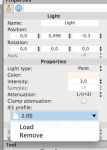IES Lighting Help request


I have been trying to understand IES Lights. I’m completely lost.
I've watched some tutorials for other 3D Apps but I still don’t know where to begin in C3D.
I don’t even know what questions to ask.
Seems there are some special images one needs. Then there is some special reader one needs.
1 Is that correct?
2 Are all images compatible with Mac as well as PC’s
3 To start out it would be nice to obtain free images.
4 Is there a good place to find these images.
5 It would be really nice if someone could put a tut together.
I realize that is a lot to ask.
Thanks just in case.
My Best
Jeanny
I have been trying to understand IES Lights. I’m completely lost.
I've watched some tutorials for other 3D Apps but I still don’t know where to begin in C3D.
I don’t even know what questions to ask.
Seems there are some special images one needs. Then there is some special reader one needs.
1 Is that correct?
2 Are all images compatible with Mac as well as PC’s
3 To start out it would be nice to obtain free images.
4 Is there a good place to find these images.
5 It would be really nice if someone could put a tut together.
I realize that is a lot to ask.
Thanks just in case.
My Best
Jeanny






